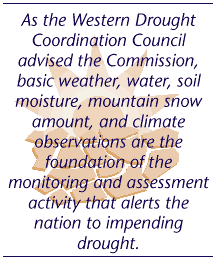|
|
||||||||||
Our findings and conclusions point out the value of observation networks, monitoring, prediction, information gateways and delivery, and research to drought preparedness. Specific Recommendations
|
||||||||||
|
|
||||||||||
The President should appropriately direct and Congress, as necessary, should authorize and fund continuation of the U.S. Drought Monitor and exploration of opportunities for its improvement and expansion. 2.3 The President should appropriately direct and Congress, as necessary, should authorize and fund continuation of Drought Predictions/Outlooks and development of techniques to improve their accuracy and frequency. 2.4 The President should appropriately direct and Congress, as necessary, should authorize and fund a comprehensive information gateway (possibly through expansion of the National Drought Mitigation Centerís website or other similar approaches) to provide users with free and open access to observation network data and drought monitoring, prediction, impact, assessment, preparedness, and mitigation measures. 2.5 The President should direct the appropriate federal agencies to develop an effective drought information delivery system such as the Unified Climate Access Network (UCAN) to communicate drought conditions and impacts to decision makers at the federal, regional, state, tribal, and local levels and to the private sector and general public. 2.6 The President should direct appropriate federal agencies to expand technology transfer of water conservation strategies and innovative water supply techniques as part of drought preparedness programs. 2.7 The President should direct and Congress should continue to adequately fund existing and future drought-related research. Existing competitive research grant programs should give high priority to drought. 2.8 The
President should direct and Congress should fund completion of the soil
survey on all lands, with special and immediate emphasis on tribal
lands. |
||||||||||
|
|
||||||||||
